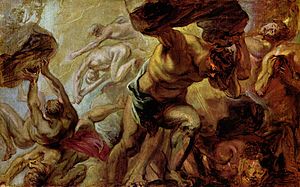Hecatoncheires
The Hekatoncheirs (Ancient Greek ἑκατόγχειρες hekatoncheires, German 'Hundertarmige', from ἑκατόν hekaton, German 'hundred' and χείρ cheir, German 'hand'; Latin Centimani) are figures of Greek mythology, three giant sons of Uranos and Gaia. Each of them has 50 heads and 100 hands. Their names are Briareos (Βριάρεως; also Obriareos), Gyges (Γύγης; also Gyes), and Kottos (Κόττος). The essential source for the myth is the Theogony of Hesiod. The name Hekatoncheiren appears relatively late in the library of Apollodorus and in Hyginus Mythographus.
Their father Uranos hated the Hekatoncheiren from the beginning, and immediately after their birth hid them in a dark place in the earth, where the sunlight never penetrated. Their mother suffered from the unjust fate of her sons and instigated her other children from the Titan race to castrate their father with a sickle of adamant, but among the Titans only Kronos was willing to do the deed.
From the prison under the earth at the edge of the world the Hekatoncheiren were freed however only by Zeus, the son of Kronos. Zeus and his siblings had been fighting an undecided war against the other Titans for 10 years (see Titanomachy). Gaia, however, had prophesied that with the help of the Hekatoncheires Zeus could achieve victory. So Zeus freed the Hekatoncheirs from Erebos, gave them nectar to drink and ambrosia to eat, thus restoring their giant strength after their long imprisonment, and strengthened them to go into battle against Zeus' enemies. Under the attack of the Hundred-Armed, the Titans collapsed: Briareos, Gyges and Kottos piled 300 rocks on top of each other and buried the Titans underneath. The defeated were bound and banished to Tartarus, but the Hekatoncheirs were appointed as their guards. Briareos also received from Poseidon the hand of his daughter Kymopolea, who bore him the nymph Oiolyke.
Briareos is also identified with Aigaion (Αἰγαίων), so in Virgil and in the Lents of Ovid. In Homer Aigaion appears as the father of Briareos, who was so called only by the gods, but that men called him Aigaion because he surpassed his father in strength. He was so powerful that even the gods were afraid to confront him: When once Hera, Poseidon and Athena had conspired to overpower and bind Zeus, Thetis summoned Briareos to Olympus, who sat down beside Zeus:
"Now this one sat by Cronion the Thunderer in joyful defiance... "
Then the gods were afraid and shunned to bind him."

The Titans collapse under the boulders hurled by the Hekatoncheirs (The Fall of the Titans by Peter Paul Rubens, 1637-1638, Musée Royaux des Beaux Arts, Brussels)
Questions and Answers
Q: Who are the Hekatonkheires?
A: The Hekatonkheires are one of the three races of beings born to Ouranos and Gaia, the primordial gods of the sky and the Earth.
Q: How many Hekatonkheires are there and what are their names?
A: There are three Hekatonkheires and their names are Kottos, Briareos, and Gyges.
Q: Why were the Hekatonkheires thrown into Tartarus?
A: The Hekatonkheires were despised by their father and were thrown into Tartarus alongside their brothers, the Elder Cyclopes.
Q: Who freed the Hekatonkheires and the Elder Cyclopes from Tartarus?
A: Zeus, alongside his brothers and sisters, freed the Hekatonkheires and the Elder Cyclopes from their prison.
Q: What did the Hekatonkheires do during the war against the Titans?
A: During the war, the Hekatonkheires threw rocks at Mount Othrys, the Titans' base, reducing the mountain to half its original size.
Q: What happened to the Titans after the Titanomachy?
A: The Titans were cast into Tartarus.
Q: What did Zeus appoint the Hekatonkheires to do after the Titanomachy?
A: Zeus appointed the Hekatonkheires to be the jailers of the Titans.
Search within the encyclopedia